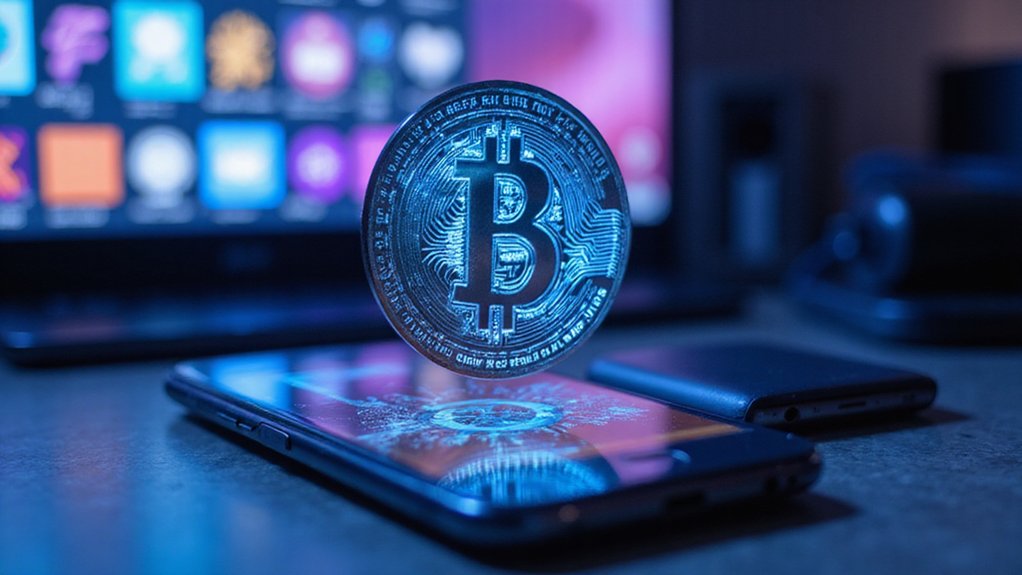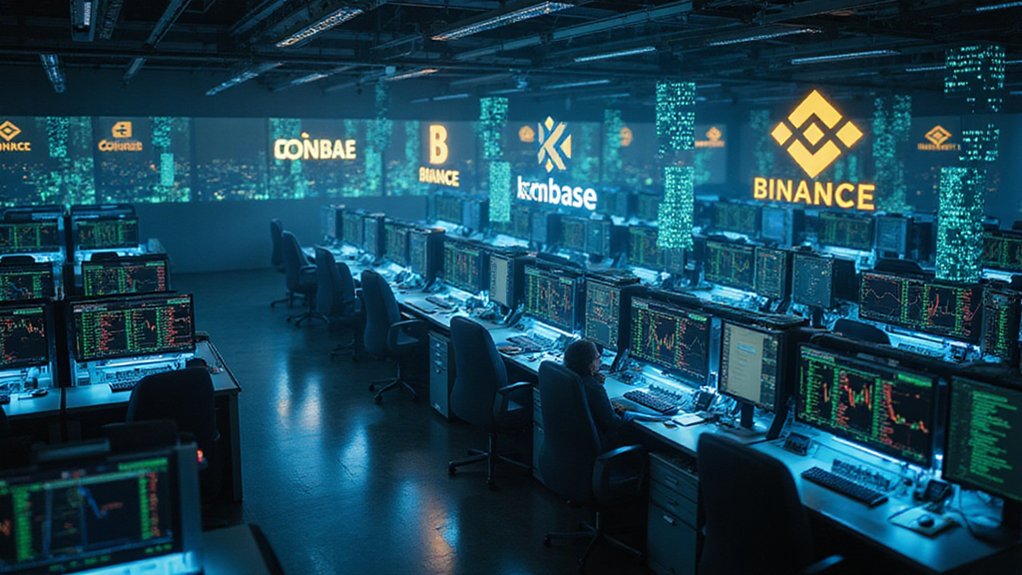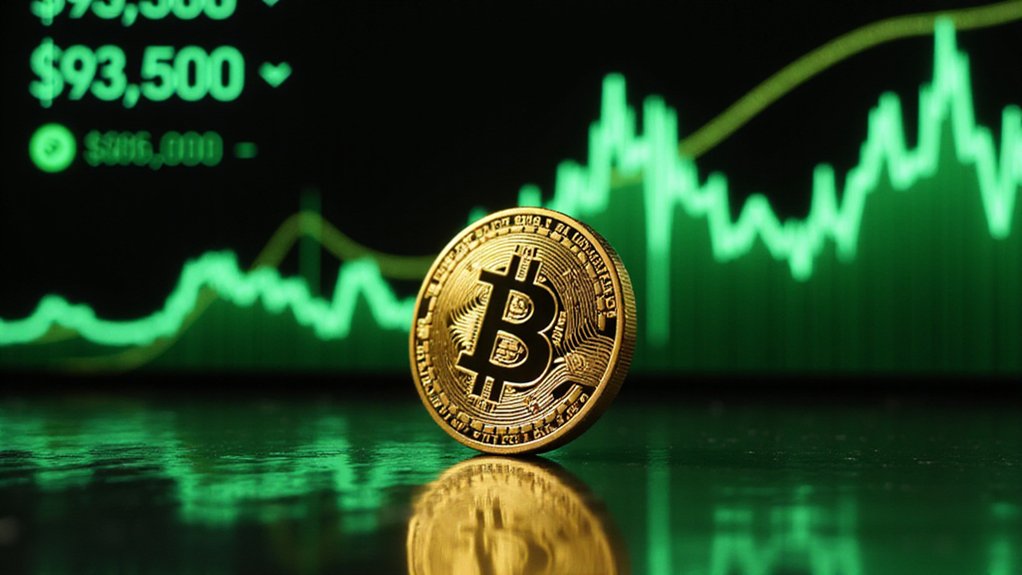NFTs (Non-Fungible Tokens) are unique digital assets stored on blockchain technology that transform infinitely replicable digital content into scarce collectibles. Unlike cryptocurrencies such as Bitcoin, each NFT possesses distinct identification codes and metadata, making it irreplaceable. Ownership of an NFT grants verifiable proof of the token itself—though importantly not copyright to the underlying work. These digital certificates of authenticity have sparked markets for art, music, gaming items, and real estate, despite their notoriously speculative nature. Further exploration reveals both surprising utility and bewildering excess.

How did unique digital certificates of ownership become among the most sought-after commodities in the blockchain universe?
Non-fungible tokens (NFTs) emerged as the digital manifestation of scarcity in an infinitely replicable online world.
In a universe of infinite digital duplication, NFTs appeared as the unexpected alchemy that transformed abundance into scarcity.
Unlike their fungible counterparts—cryptocurrencies such as Bitcoin or Ethereum—these cryptographic tokens represent ownership of something singular and irreplaceable, be it digital artwork, music, collectibles, or even tokenized real-world assets.
The technological architecture underpinning NFTs relies primarily on blockchain networks, with Ethereum’s ERC-721 and ERC-1155 standards providing the predominant frameworks for their creation and transfer.
Each token contains unique identification codes and metadata that distinguish it from every other digital asset on the ledger.
This immutable record of provenance and ownership—traceable through a decentralized public ledger—creates verifiable authenticity in an environment historically plagued by replication.
Crucially, purchasing an NFT doesn’t necessarily confer copyright or intellectual property rights to the underlying content (a distinction perhaps lost on many enthusiastic buyers*).
Token holders typically receive proof of ownership of the NFT itself, while creators may retain rights to produce additional tokens or utilize the original work elsewhere—absent explicit terms to the contrary.
The applications extend beyond digital art speculation, though that market has generated the most headlines.
Gaming ecosystems employ NFTs for unique in-game items; musicians tokenize albums and experiences; real estate transactions leverage them to streamline property transfers.
The financial mechanics support secondary markets where creators can earn ongoing royalties—a notable innovation in traditional asset transactions.
While proponents herald NFTs as revolutionary tools for creator economies, critics highlight their speculative nature, environmental costs (particularly on proof-of-work blockchains), and occasional disconnect between perceived and fundamental value.
For beginners looking to participate in this space, the process involves choosing a digital format, setting up a crypto wallet, and using NFT marketplaces like OpenSea or Rarible to mint and sell their creations.
One of the earliest and most influential NFT projects was CryptoKitties game, which allowed users to collect and breed digital cats with unique attributes on the Ethereum blockchain.
The market remains characterized by its volatility—where pixelated images might command millions while identical copies circulate freely, a paradox that perfectly encapsulates the peculiar economics of digital scarcity.
By September 2023, the speculative bubble had largely burst with over 95% of collections holding no meaningful market value.
*A phenomenon perhaps deserving its own scholarly examination.
Frequently Asked Questions
Can NFTS Lose Value Over Time?
NFTs can indeed depreciate substantially—often precipitously—due to numerous factors.
Market oversaturation, waning creator relevance, abandoned development roadmaps, and technical obsolescence frequently erode valuations.
Smart contract vulnerabilities, metadata dependencies, and regulatory uncertainties further accelerate depreciation trajectories.
While certain blue-chip collections maintain relative stability, the vast majority of tokens experience significant value deterioration—a sobering reality that contrasts sharply with early speculative exuberance in the space.
How Do I Store NFTS Safely?
Storing NFTs safely requires a layered security approach.
Hardware wallets (Ledger, Trezor) offer superior protection by keeping private keys offline, while software wallets like MetaMask provide convenience but greater vulnerability.
For true security, one should employ hardware storage coupled with decentralized metadata solutions like IPFS/Filecoin.
Regular backups of seed phrases, stored securely offline, guarantee recovery options—an essential safeguard in the volatile digital collectibles space where a compromised wallet means permanent asset loss.
Are There Environmental Concerns With NFTS?
Environmental concerns with NFTs are legitimate and multifaceted.
Traditional Proof-of-Work blockchain transactions—particularly on Ethereum pre-Merge—generated substantial carbon footprints (approximately 211kg CO₂ per NFT lifecycle).
Major collections have produced millions of kilograms of emissions cumulatively.
However, the industry is adapting through Proof-of-Stake migrations (reducing energy use by ~99.95%), layer-2 scaling solutions, and carbon offset initiatives—developments that, while promising, haven’t fully neutralized legitimate ecological criticisms.
What Marketplaces Are Best for Selling NFTS?
The marketplace selection for NFT sellers diverges based on one’s trading proclivities.
OpenSea dominates as the accessible behemoth with multi-chain support and royalty protection—ideal for newcomers.
Blur caters to the high-volume trader contingent with its zero-fee structure and advanced analytics.
Meanwhile, Magic Eden attracts Solana enthusiasts seeking lower transaction costs.
Each platform offers distinct advantages; the best choice hinges on one’s blockchain preference, trading sophistication, and fee tolerance.
Can NFTS Be Stolen or Duplicated?
While NFTs themselves—as blockchain-recorded tokens—cannot be duplicated, they can certainly be stolen through sophisticated phishing schemes, compromised wallets, and social engineering tactics.
With over $100 million in NFTs pilfered between 2021-2022 (including 167 Bored Apes), thieves primarily target private keys and seed phrases.
The digital assets linked to NFTs can be copied, naturally, but these replicas lack the blockchain-verified provenance that confers value.









